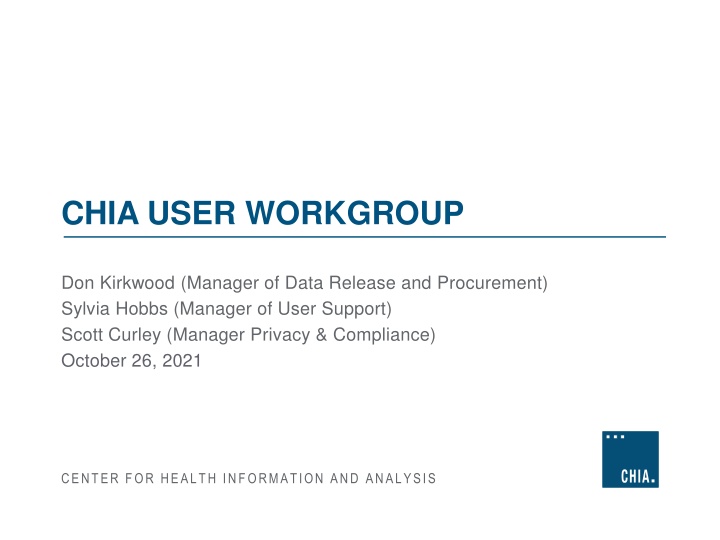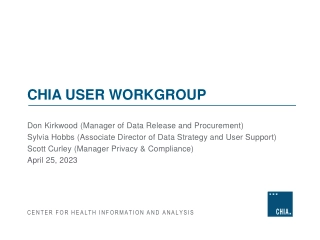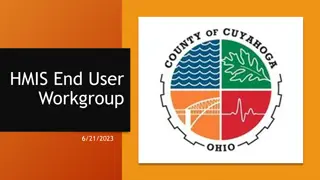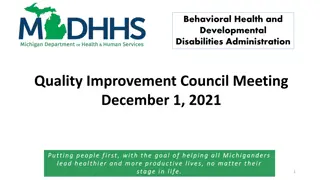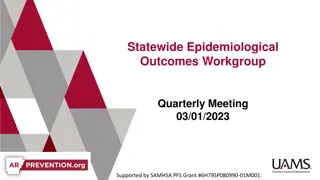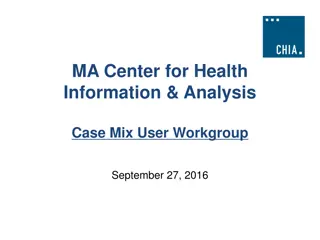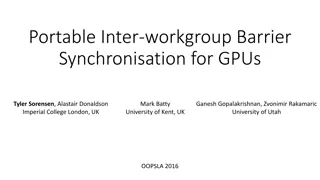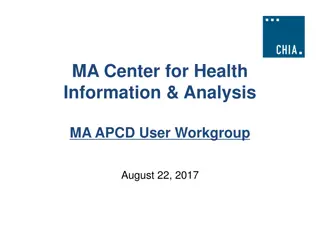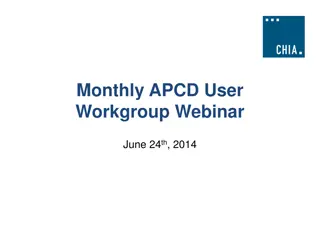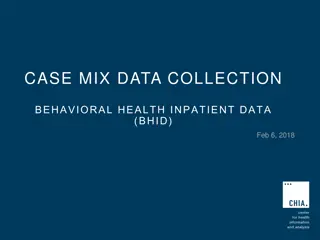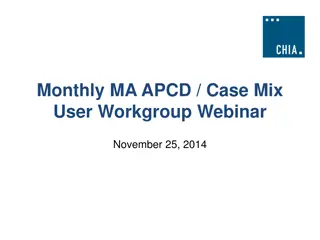CHIA USER WORKGROUP
The liver is vital for nutrient breakdown and synthesis of various molecules but can be affected by chronic liver disease in dogs and cats. Learn about different etiologies, clinical signs, and challenges associated with chronic hepatitis and cholangitis in small animals.
Download Presentation

Please find below an Image/Link to download the presentation.
The content on the website is provided AS IS for your information and personal use only. It may not be sold, licensed, or shared on other websites without obtaining consent from the author.If you encounter any issues during the download, it is possible that the publisher has removed the file from their server.
You are allowed to download the files provided on this website for personal or commercial use, subject to the condition that they are used lawfully. All files are the property of their respective owners.
The content on the website is provided AS IS for your information and personal use only. It may not be sold, licensed, or shared on other websites without obtaining consent from the author.
E N D
Presentation Transcript
CHIA USER WORKGROUP Don Kirkwood (Manager of Data Release and Procurement) Sylvia Hobbs (Manager of User Support) Scott Curley (Manager Privacy & Compliance) October 26, 2021 CENTER FOR HEALTH INFORMATION AND ANALYSIS
Agenda Announcements: APCD Release 9.0/10.0 Updates FY20 Case Mix Release Projections Data Release and Application Update Website Updates Application Reminders User Support Questions Observation Stay Procedures Interfacility Transfers Condition Present on Admission DRG Versions Q&A 2 User Workgroup | CHIA User Support
MA APCD Release 9.0/10.0 Available Late Fall / Early Winter Applicants with approved projects that require updated APCD data (Release 9.0/10.0) should submit to CHIA a completed Exhibit B (Certificate of Continued Need and Compliance) of the Data Use Agreement. After submitting a completed Exhibit B you will receive an invoice (if applicable) for the requested data. Upon payment of the invoice the order for the data will be placed. Release 9.0/10.0 includes data on services from January 2015 December 2020 with six months of claim runout. 3 User Workgroup | CHIA User Support
Case Mix FY20 Release *CURRENT* RELEASE TIMEFRAMES FOR EACH FILE: Inpatient (HIDD) Available for request Emergency Department (ED) Available for request Outpatient Observation (OOD) Applicants with approved projects that require newly available year(s) of Case Mix Data (e.g., FY 19) should submit to CHIA a completed Exhibit B (Certificate of Continued Need and Compliance) of the Data Use Agreement. After submitting a completed Exhibit B you will receive an invoice (if applicable) for the requested data. Upon payment of the invoice the order for the data will be placed. Mid-Fall 2021 4 User Workgroup| CHIA User Support
Data Release and Application Updates Due to Governor Baker s emergency actions to limit the spread of COVID-19 CHIA s workforce will be remote, for now. This arrangement will limit CHIA s ability to produce and deliver data extracts. At this time, CHIA is releasing data and providing extracts to requestors. During this time, CHIA will continue to accept and review data applications for both Case Mix and All-Payer Claims Database (MA APCD) datasets. Review committees, DRC and DPC, will continue their meetings remotely as necessary. Due to CHIA s physical office being closed, applications will be accepted without a fee. After receipt of the application, CHIA will issue an invoice which will allow applicants to remit payment online. If you are a Data User that has a CHIA hard drive in your possession, please keep the hard drive at this time while CHIA s physical office is closed. 5 User Workgroup| CHIA User Support
Website Release Updates Updates on the production of APCD and Case Mix databases and status of data requests are now posted to CHIA s website! Aim #1 is to provide weekly or bi-weekly status update on CHIA data products as they are in development. Aim #2 is to provide applicants with information about expected fulfillment status for individual data requests. Request IDs will be communicated to Data Requestors via email. Please visit http://www.chiamass.gov/status-of-data-requests/ to see the current status of releases. User Workgroup| CHIA User Support 6
Fee Waiver Request Reminders 1. If you re submitting a request for a fee waiver, remember to include the fee remittance form in your application package on IRBNet. Remember to submit supporting documentation (if required). If you re requesting a financial hardship waiver, remember to submit information detailing your project s financial situation (examples: project budget, grant funding, organizational / departmental funding). Also request to pay a specific price that you reasonably believe you re able to afford to contribute. CHIA generally does not offer full financial hardship fee waivers. We expect all applicants to have made an attempt to find funding to cover the full cost of the data fees. Fee waiver requests can take some time to process especially financial hardship requests. 2. 3. 4. 5. 8 User Workgroup | CHIA User Support
Question Question: I am applying for the inpatient hospital discharge data and : I am applying for the inpatient hospital discharge data and am concerned about the magnitude of procedures I might be missing am concerned about the magnitude of procedures I might be missing by not including the outpatient observation stay data in my request. by not including the outpatient observation stay data in my request. What types of procedures are performed in observation stay and are What types of procedures are performed in observation stay and are these any of the same types of procedures that might be performed in these any of the same types of procedures that might be performed in an inpatient care setting? an inpatient care setting? Answer: Yes, although at a smaller volume, many of same procedures performed in the hospital inpatient care setting also appear in the outpatient observation stay data, including percutaneous transluminal coronary angioplasty, oophorectomy, prostatectomy, hysterectomy, knee arthroplasty, hip replacement, spinal fusion, to name a few. The following table shows a ranking of the top ICD-10-PCS procedures using AHRQ s Clinical Classifications Software (CCS) Groupings for procedures performed FY2015 through FY2020. Comparison of Top 10 CCS Procedure Code Groups in Observation Stay and Inpatient Discharge Data Observation Stay Top 10 CCS Procedure Categories Diagnostic cardiac catheterization; coronary arteriography 2 Upper gastrointestinal endoscopy; biopsy 3 Appendectomy 4 Tonsillectomy and/or adenoidectomy 5 Fetal measurement and monitoring Other OR procedures on vessels other than head and neck 7 Other OR procedures on mouth and throat 9 Prophylactic vaccinations and inoculations 9 Cholecystectomy and common duct exploration 10 Insertion; revision; replacement; removal of cardiac pacemaker or cardioverter/defibrillator Inpatient Discharge Top 10 CCS Procedure Categories Rank Rank 1 1 2 3 4 5 Respiratory intubation and mechanical ventilation Blood transfusion Prophylactic vaccinations and inoculations Other procedures to assist delivery Other vascular catheterization; not heart Diagnostic cardiac catheterization; coronary arteriography Other therapeutic procedures Fetal measurement and monitoring Upper gastrointestinal endoscopy; biopsy Other therapeutic procedures on muscles and tendons 6 6 7 9 9 10 Continued Continued
Answer (continued): While observation stay data does have many of the same ICD-10-PCS procedures found in the inpatient care setting, as you can see in Figure 1 below, from FY2016 to FY2020, only on small volume of observation stays had such procedures. In Figure 2 below, you will see that the percent of patients with such codes has trended downward from 10% in FY2016 to 6% in FY2020. Figure 1. FY2016 to FY2020 Volume of Observation Stays with ICD-10-PCS Procedures Total Observation Stays Stays with ICD-10-PCS Procedures 250000 200000 216280 216037 214997 213639 183567 150000 100000 50000 22002 20261 19164 14111 11836 0 2016 2017 2018 2019 2020 Figure 2. Downward Trend in Percent of Stays with ICD-10-PCS Procedures 15.0% 10.2% 9.4% 9.0% 10.0% 6.5% 6.4% 5.0% 0.0% 2016 2017 2018 2019 2020 Percent Stays with ICD-10-PCS Procedures Continued Continued
Answer (continued): Given the lower and moderate complexity of many observations, the highest volume of procedures are recorded in CPT codes for tests performed during the stay and for the stay itself. FY2016 to FY2020 Top 10 CPT Procedure Codes in Outpatient Observation Stay Data Description CPT Code 2016 2017 2018 2019 2020 Initial observation care, per day, for evaluation and management of patient which requires these 3 key components: A detailed or comprehensive history; A detailed or comprehensive exam; and Medical decision making that is straightforward or of low complexity. Collection of venous blood by venipuncture 99218 36415 51731 68636 65141 64914 78877 77049 92013 69620 62616 52322 Blood count; complete (CBC), automated (Hgb, Hct, RBC, WBC and platelet count) and automated differential WBC count Basic metabolic panel (Calcium, total) This panel must include the following: Calcium, total (82310) Carbon dioxide (bicarbonate) (82374) Chloride (82435) Creatinine (82565) Glucose (82947) Potassium (84132) Sodium (84295) Urea nitrogen (BUN) (84520) Comprehensive metabolic panel This panel must include the following: Albumin (82040) Bilirubin, total (82247) Calcium, total (82310) Carbon dioxide (bicarbonate) (82374) Chloride (82435) Creatinine (82565) Glucose (82947) Phosphatase, alkaline (84075) Potassium (84132) Protein, total (84155) Sodium (84295) Transferase, alanine amino (ALT) (SGPT) (84460) Transferase, aspartate amino (AST) (SGOT) (84450) Urea nitrogen (BUN) (84520) Electrocardiogram, routine ECG with at least 12 leads; tracing only, without interpretation and report Troponin, quantitative Initial observation care, per day, for evaluation and management of a patient, which requires these 3 key components: A comprehensive history; A comprehensive examination; and Medical decision making of moderate complexity. Counseling and/or coordination of care with other physicians, other health care professionals, or agencies are provided consistent with the nature of the problem(s) and the patient s and/or family s needs. Emergency department visit for the evaluation and management of a patient, which requires these 3 key components within the constraints imposed by the urgency of the patient's clinical condition and/or mental status: A comprehensive history; A comprehensive examination; and Medical decision making of high complexity. Prothrombin time; 85025 21731 29089 38452 62355 55727 80048 31180 32916 39461 47870 37046 80053 28607 28266 32159 43636 36737 93005 84484 16916 9158 22726 11085 24369 16305 31959 28238 26995 27713 99219 15298 16327 15838 18559 14740 99285 85610 6924 6357 7966 7518 12453 8267 Continued Continued 18700 13008 15785 13215
Answer (continued): If the source of the observation stay originates from a prior ED visit, a CPT code for that visit is in the observation stay record (see Table 1 below). CPT code 99285 for high complexity ED visit patients is in the top 10 of CPTs for observation stays. As you can see in Figure 1, while the of low to moderate complexity patients admitted to observation stay from the ED has fluctuated, the number of high complexity ED patients in observation stay has more than doubled. Table 1. CPT Codes in Observation Stay for Patients with prior ED Visit CPT Code CPT 99281 CPT 99282 CPT 99283 CPT 99284 CPT 99285 Description ED visit for the evaluation and management of a patient, which requires these 3 key components: A problem focused history; A problem focused examination; and Straightforward medical decision making. ED visit for the evaluation and management of a patient, which requires these 3 key components: An expanded problem focused history; An expanded problem focused exam; and Medical decision making of low complexity. ED visit for the evaluation and management of a patient, which requires these 3 key components: An expanded problem focused history; An expanded problem focused exam; and Medical decision making of moderate complexity. ED visit for the evaluation and management of a patient, which requires these 3 key components: A detailed history; A detailed exam; and Medical decision making of moderate complexity. ED visit for the evaluation and management of a patient, which requires these 3 key components within the constraints imposed by the urgency of the patient's clinical condition and/or mental status: A comprehensive history; A comprehensive exam; and Medical decision making of high complexity. Table 1. CPT Codes in Observation Stay for Patients with prior ED Visit CPT Codes 99281 through 99284 CPT Code 99285 18700 20500 15785 12453 16500 12500 7966 6924 8500 1378 1300 1198 4500 1168 649 500 2016 2017 2018 2019 2020
Interfacility Transfers Question Question: I am confused by how interfacility transfers are presented : I am confused by how interfacility transfers are presented in the case mix data. Specifically, is the field IdOrgTransfer intended in the case mix data. Specifically, is the field IdOrgTransfer intended to represent the source to represent the source from which from which the patient who has a discharge record has been transferred from or does it represent the destination record has been transferred from or does it represent the destination to which to which the patient is being transferred? the patient is being transferred? the patient who has a discharge Answer: In the case mix filing specifications, hospitals are instructed to use the IdOrgTransfer field to report the transfer organization ID for the facility from which the patient has been transferred. This field is reported if the Primary or Secondary Source of Admission is any of the following: 4 - Transfer from an Acute Hospital 7 - Outside Hospital Emergency Room Transfer, 5 - Transfer from an SNF Facility, 6 - Intermediate Care Facility, or V - Transfer from another facility to a Medicare-approved swing bed 9 - Other (to include Level 4 Nursing Facility) and the transfer facility is a Level 4 Nursing Facility/Rest Home If the hospital provider, nursing facility/rest home or other facility from which the patient is transferred is outside Massachusetts, then the transfer OrgID reported must be 9999999.
Question Question: I am applying for the case mix hospital inpatient discharge data. The condition present on : I am applying for the case mix hospital inpatient discharge data. The condition present on admission (POA) indicators are part of the LDS release product given to all approved data applicants. I admission (POA) indicators are part of the LDS release product given to all approved data applicants. I only intend to import in and store the data elements relevant to my analysis. I typically quantify diagnosis only intend to import in and store the data elements relevant to my analysis. I typically quantify diagnosis codes and calculate rates without ever using the POA indicators. I had assumed that most conditions are codes and calculate rates without ever using the POA indicators. I had assumed that most conditions are present on admission. I am still in the process of filling out my application and would like to get a sense present on admission. I am still in the process of filling out my application and would like to get a sense of the magnitude of diagnosis codes in any given year that are of the magnitude of diagnosis codes in any given year that are not the conditions that those diagnosis describe. the conditions that those diagnosis describe. not present on admission and what are present on admission and what are Answer: From FY2016 to FY2020, the percent of patients discharged with a condition not present on admission has trended upward from 24.3% in FY2016 to 31.3% in FY2020 (See Figure 1 below). Each year, the conditions not present on admission only represent a small proportion of all diagnosis, from 5.1% in FY2016 to 6.0% in FY2020 (See Figure 2 below. The top 10 conditions not present on admission include diagnosis codes for delivery and neonate complications, kidney failure, anemia, palliative care and do not resuscitate. (See Table 1 below). Table 1. Top 10 Conditions Not POA Figure 1. Percent of Total Discharges with a Condition Not POA Description DX Code 40.0% 31.3% 29.8% 27.6% 25.8% 24.3% 30.0% Acute posthemorrhagic anemia Acute kidney failure, unspecified D62 20.0% N179 10.0% Second degree perineal laceration during delivery Hypokalemia Encounter for palliative care Do not resuscitate 0.0% O701 2016 2017 2018 2019 2020 E876 Z515 Figure 2. Percent of Total Diagnoses Codes Not POA Z66 6.5% Abnormality in fetal heart rate and rhythm complicating labor and delivery Hypotension, unspecified 6.0% 5.8% 6.0% O76 5.3% 5.5% 5.1% 5.1% I959 5.0% First degree perineal laceration during delivery Neonatal jaundice, unspecified O700 4.5% P599 2016 2017 2018 2019 2020
Question Question: CHIA releases multiple versions of the DRG groupers each year : CHIA releases multiple versions of the DRG groupers each year to facilitate longitudinal across year comparison using the same DRG to facilitate longitudinal across year comparison using the same DRG version. In the FY2020 inpatient hospital discharge data, do different version. In the FY2020 inpatient hospital discharge data, do different version of the APR version of the APR- -DRG group the diagnosis cod for COVID DRG group the diagnosis cod for COVID- -19 differently? APR DRG 19 differently? Answer: The older APR-DRG Versions 30.0 and 34.0 assign more patients with a principal diagnosis of COVID-19 to the surgical DRG (MODERATELY EXTENSIVE O.R. PROCEDURE UNRELATED TO PRINCIPAL DIAGNOSIS). The newer APR-DRGs Version 36.0 assigns those same COVID-19 patients to the medical DRG (RESPIRATORY SYSTEM DIAGNOSIS WITH VENTILATOR SUPPORT > 96 HOURS) or the medical DRG (MAJOR RESPIRATORY INFECTIONS AND INFLAMMATIONS). The table below compares by APR-DRG version the DRG assignment of the patients with a principal DX of COVID-19 in the FY2020 HIDD for the top 10 groupings representing 12,946 of the 13,100 patients. FY2020 Hospital Inpatient Discharge Data Comparison of COVID-19 Principal Diagnosis Cases by APR DRG Version for the Top 10 Grouping Assignments ( n= 12,946 of the total 13,100 principal DX cases) APR DRG Version 36.0 137 130 130 137 005 130 004 005 951 137 APR DRG Version 34.0 137 951 130 951 004 951 004 005 951 951 APR DRG Version 30.0 137 951 130 951 004 130 004 005 951 137 APR DRG Version 26.1 137 951 130 951 004 130 004 005 951 137 APR DRG Version 20.0_ 723 710 723 710 004 723 004 005 710 723 PRINCIPAL DX COVID U071 U071 U071 U071 U071 U071 U071 U071 U071 U071 Number of Discharges 11531 481 429 220 138 36 31 30 27 23
Where can I find past User Workgroup Presentations? http://www.chiamass.gov/ma-apcd-and-case-mix-user-workgroup- information/ 17 User Workgroup | CHIA User Support
When is the next User Group meeting? The next User Group will meet Tuesday, November 23. http://www.chiamass.gov/ma-apcd-and-case-mix-user-workgroup- information/
Resultant Research Using CHIA Data https://www.chiamass.gov/resultant-research-using-chia-data
Questions? Questions related to MA APCD: apcd.data@chiamass.gov Questions related to Case Mix: casemix.data@chiamass.gov REMINDER: Please include your IRBNet ID#, if you currently have a project using CHIA data. 20 User Workgroup | CHIA User Support
Call for Topics and Presenters If there is a TOPIC that you would like to see discussed at an MA APCD or Case Mix workgroup in 2021, contact Amy Wyeth [amy.wyeth@chiamass.gov] If you are interested in PRESENTING at a MA APCD or Case Mix workgroup in 2021, contact Amy Wyeth [amy.wyeth@chiamass.gov] You can present remotely, or in-person at CHIA We may be reaching out to some data users with invitations to present, and hope you will consider this! 21 User Workgroup | CHIA User Support
